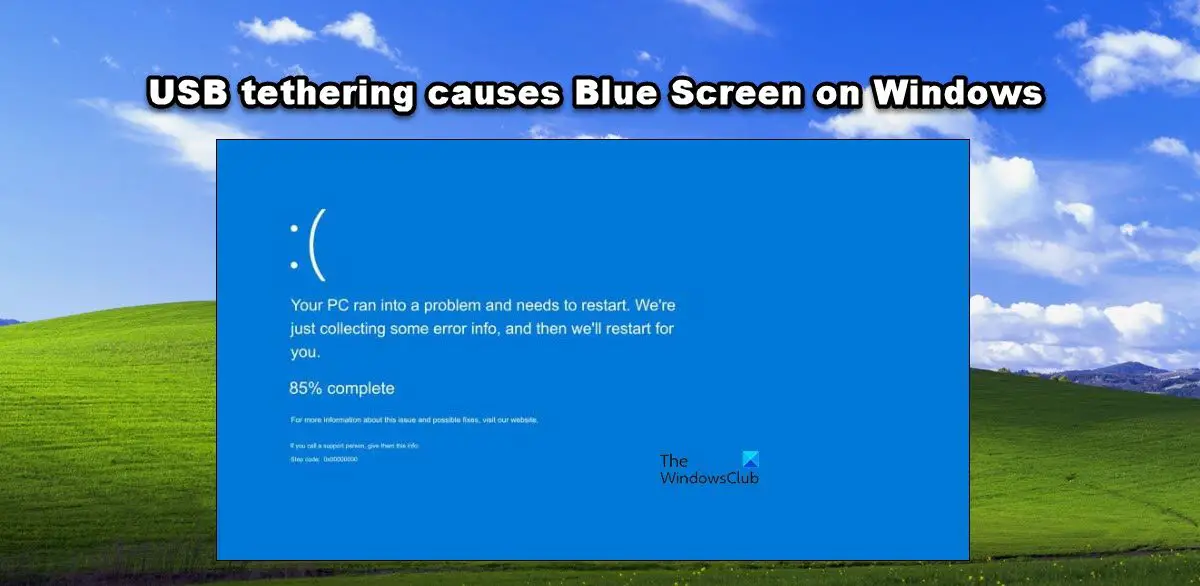Fix USB tethering causes Blue Screen on Windows 11/10
If USB tethering causes Blue Screen on your Windows computer, follow the solutions mentioned below. Let us talk about them in detail.
1] Check your cable and use a different port
There is a possibility that the BSOD is caused due to the hardware malfunctioning. Mostly, it is your cable but sometimes, your port can be at fault as well. You should first use a different cable and see if that resolves the error, if not, connect to a different port on your computer and see if the issue is resolved. Hopefully, this will do the trick for you.
2] Switch to a different driver
When you connect your phone to the computer, they communicate with each other via a driver present on your computer. So, since you encountered BSOD issues when using USB tethering, there is a huge possibility that the driver your computer is using is not compatible. In that case, we need to switch to a different driver to resolve the issue. To do the same, make sure that USB tethering is enabled on your device and it is connected to your computer, then, follow the prescribed steps. Finally, check if the issue is resolved.
3] Reinstall your USB driver
You may also encounter the error in question if your drivers are corrupted. However, if the driver is corrupted, you can easily reinstall it and replace them with new drivers. But before that, there are a few things we need to do. First of all, open Command Prompt and run the following command to stop the netsetupsvc service. Now, follow these steps to reinstall the driver. After reinstalling the driver, we need to make some changes to the registry.
Before that, we need to find the GUID of the USB tethering driver. To do the same, open Device Manager, expand Network adapters, right-click on the USB tethering driver, select Properties, go to Details, change Property to Class GUID, and copy the string (right-click on it and select Copy).
Next, open Registry Editor and navigate to the following location.
Note: Replace
IfType: 6MediaType: 0PhysicalMediaType: 0xe
Finally, run the following command in the elevated mode of CMD to enable the service we stopped earlier. Hopefully, this will help you. Read: USB tethering not working on Windows PC.
4] Run Network Adapter troubleshooter
Windows has a Network Adapter troubleshooter that will allow you to scan and repair the issue. To do the same, follow the prescribed steps. Windows 11 Windows 10 Follow the on-screen instructions to complete troubleshooting. Hopefully, this will do the job for you.
5] Repair System Files
If nothing worked, then maybe your system files are corrupted and need to be repaired. You can either run SFC and DISM commands or repair OS using Installation media. Once your system image is repaired, you won’t encounter any BSOD. Hope you are able to resolve the issue using the solutions mentioned in this post. Read: Fix Mobile Tethering Internet keeps disconnecting on Windows
Can USB tethering cause BSOD?
Yes, USB tethering could cause BSOD on Windows 11 as well as Windows 10. It mainly happens when your mobile is infected with a malware or your computer has a faulty driver. In that case, you can follow the aforementioned solutions to fix the BSOD problem caused by USB tethering.
What causes blue screen on Windows 11?
You will see a Blue Screen of Death or BSOD when there is some incompatible driver, corrupted system files, or some application that’s interfering with the Windows process. Mostly, the Microsoft Online Blue Screen troubleshooter will scan and repair the issue, if that fails, you should first check what has failed and then how it can be resolved.
